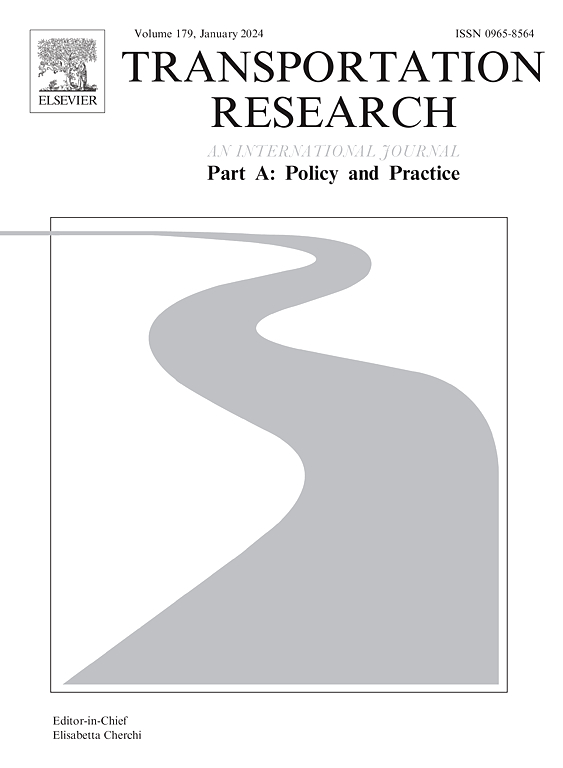A flight risk field model for advanced low-altitude transportation system using field theory
IF 6.3
1区 工程技术
Q1 ECONOMICS
Transportation Research Part A-Policy and Practice
Pub Date : 2024-10-08
DOI:10.1016/j.tra.2024.104268
引用次数: 0
Abstract
Traffic congestion, as a global issue, often leads to adverse social impacts and huge economic losses, especially in urban areas. Utilizing the available urban low-altitude airspace (ULA) is a potential and promising solution to this problem. To fully leveraging ULA and establishing an advanced low-altitude transportation (ALT) system, ensuring the safety of low-altitude flight is of critical importance. However, the ALT system is currently in the exploratory and developmental stage, and the assessment of flight safety relies primarily on pre-flight evaluations and third-party risk indicators. This study introduces a novel flight risk field model considering risk factors during UAV cruising by introducing a new concept of a flight risk field. The model takes into account the key factors influencing the safety of low-altitude flights, considering both the static characteristics of buildings and the dynamic movements of unmanned aerial vehicles (UAVs). It is capable of reflecting the spatiotemporal variations in flight risks during the UAV cruising process. Finally, the model is validated through numerical examples and simulations. The contribution of this paper is to provide a new idea and method for the safety assessment of the ALT system, which can be further applied to airspace structure design, route optimization, and constitution of traffic regulations, to ensure a reasonable airspace design and enhance the safety of low-altitude flight activities.
利用场论建立先进低空运输系统的飞行风险场模型
交通拥堵作为一个全球性问题,往往会导致不良的社会影响和巨大的经济损失,尤其是在城市地区。利用现有的城市低空空域(ULA)是解决这一问题的一个潜在可行的办法。要充分利用城市低空空域并建立先进的低空交通(ALT)系统,确保低空飞行安全至关重要。然而,ALT 系统目前还处于探索和发展阶段,对飞行安全的评估主要依赖于飞行前评估和第三方风险指标。本研究通过引入飞行风险场这一新概念,引入了一种考虑无人机巡航过程中风险因素的新型飞行风险场模型。该模型考虑了影响低空飞行安全的关键因素,同时考虑了建筑物的静态特征和无人机(UAV)的动态运动。该模型能够反映无人飞行器巡航过程中飞行风险的时空变化。最后,通过数值示例和模拟验证了该模型。本文的贡献在于为 ALT 系统的安全评估提供了一种新的思路和方法,可进一步应用于空域结构设计、航线优化和交通法规的制定,以确保空域设计的合理性,提高低空飞行活动的安全性。
本文章由计算机程序翻译,如有差异,请以英文原文为准。
求助全文
约1分钟内获得全文
求助全文
来源期刊
CiteScore
13.20
自引率
7.80%
发文量
257
审稿时长
9.8 months
期刊介绍:
Transportation Research: Part A contains papers of general interest in all passenger and freight transportation modes: policy analysis, formulation and evaluation; planning; interaction with the political, socioeconomic and physical environment; design, management and evaluation of transportation systems. Topics are approached from any discipline or perspective: economics, engineering, sociology, psychology, etc. Case studies, survey and expository papers are included, as are articles which contribute to unification of the field, or to an understanding of the comparative aspects of different systems. Papers which assess the scope for technological innovation within a social or political framework are also published. The journal is international, and places equal emphasis on the problems of industrialized and non-industrialized regions.
Part A''s aims and scope are complementary to Transportation Research Part B: Methodological, Part C: Emerging Technologies and Part D: Transport and Environment. Part E: Logistics and Transportation Review. Part F: Traffic Psychology and Behaviour. The complete set forms the most cohesive and comprehensive reference of current research in transportation science.

 求助内容:
求助内容: 应助结果提醒方式:
应助结果提醒方式:


